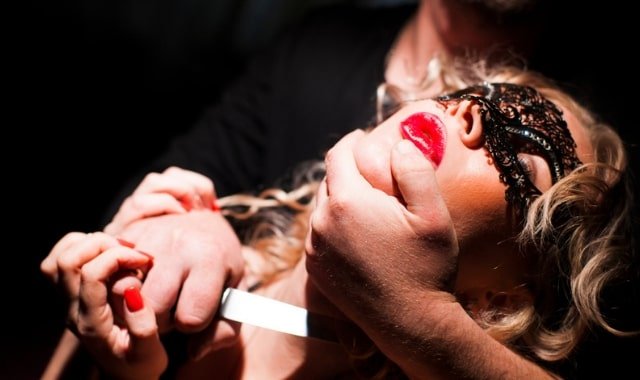What comes to mind when you think of safe words? Maybe the frantic screeching of, “Pineapple, congress, monkey, asshole!” as someone tries to remember it? Or is it just something “paranoid” kinky people use to stop all the “fun?” Writer Kayla Lords explains the BDSM safe word basics.
It doesn't matter if you follow Safe, Sane, and Consensual (SSC), Risk Aware Consensual Kink (RACK), or even Personal Responsibility, Informed Consensual Kink (PRICK), the BDSM safe word has a place in all of them. They shouldn't be the only method you and your partner rely on to keep everyone healthy and whole, but they shouldn't be ignored either.
What is a BDSM safe word?
In a situation where one partner gives up control, and the other one takes it - whether you consider yourself into BDSM or not - 'No' doesn't always mean "No". Most of the time “No” means, “Yes, please, God, more, hurt me!” In a situation like that the only way to let someone know you really need to stop, that you're in pain or distress, or that something bad has happened is to use a word that is entirely out of context with the situation.
A BDSM safe word can be anything. Eggplant. Snickerdoodle. Schmoopy Pants. In my relationship, we use the colour system. During scenes, my Dominant frequently asks me for colour. Green means keep going, don't stop. Yellow means slow down. For me, it often means “Slow down with that particular torture device.” Red means stop everything. Outside of a scene, when we're just having good old kinky sex, “Red” is what I use if I feel pain (in a bad way), sick, or something seems very, very wrong.
What do you do if you can't say your BDSM safe word?
Maybe you're bound and gagged. Verbal communication is completely out. But you still need to play safe and need something to help communicate distress or a problem. A gesture of some sort is a common alternative. Some tops/Dominants will have their partner hold something, and if they drop it, that's the “safe word.” Others might ask for a specific hand signal, snapping of fingers, something out of the ordinary that allows you to communicate that you need to stop.
On the other hand, even that isn't a failsafe. Subspace - the floaty feeling that some submissives/bottoms feel when endorphins and feel-good hormones and brainwaves kick in - can impair a person's ability to communicate. Tops and Dominants should keep their eyes on their partner at all times. If they can't respond to questions or are no longer reacting to stimuli, play may need to stop even though a BDSM safe word or gesture wasn't given.

A BDSM safe word can also be a hand signal
What happens after a BDSM safe word is used?
Well, the obvious answer is everything stops. In most cases, a top or Dominant will stop all play. Everything shuts down. The ropes, blindfold, gag, and whatever else come off. The spanking paddles, floggers, and other toys are put away. Aftercare should begin immediately. For anyone like me in a long-term loving D/s relationship, aftercare probably involves a lot of cuddles, kisses, and warm fuzzy feelings.
Play partners who aren't that intimate should have some sort of aftercare ritual. Whether it's water, a blanket, and quiet conversation or even sitting silently until the bottom/submissive comes back around, something needs to be done. Once everyone is safe and able to communicate again, you need to talk about what happened. It doesn't matter if it was an awkward angle that caused scary (not good) pain or fear that was triggered; it's all worthy of discussion. Talking it out is one way to prevent the problem from surfacing again, or to deal with issues neither of you might have ever considered before.
Be warned: everyone needs a BDSM safe word
Some people will say they don't need to use a BDSM safe word. Whether you've been with your partner for 30 years or you just met yesterday, I caution you against that kind of thinking. Anything can happen at any time.
As focused as a Dominant may be, no one is infallible. They could miss the signs of illness or extreme pain. They might not see the awkward angle of an arm or leg. It doesn't mean they're careless - it means they're human. You both need a way to be able to stop your scene or kinky fuckery before something goes terribly wrong. A BDSM safe word should always be an option.
Kayla Lords is a freelance writer, sex blogger, and a masochistic babygirl living the 24/7 D/s life.
What's your BDSM safe word? Something that sounds utterly ludicrous? Compare it with fellow kinksters on the Fetish.com forum.
Images: via Shutterstock.com
-
 1
1
.gif.81d0c0442ce9717e871ade8e7d5b0dd8.gif)

-min.jpg.00359db11b75798e06a5b6bc26667db8.jpg)





Join the conversation
You can post now and register later. If you have an account, sign in now to post with your account.